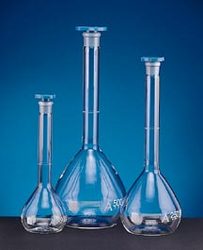3.31 AS Inorganic Chemistry - Preparation of volumetric solutions
Volumetric analysis
 Volumetric
analysis is the determination of an unknown solution by reaction with a solution
of known concentration. The apparatus used is standard glassware.
Volumetric
analysis is the determination of an unknown solution by reaction with a solution
of known concentration. The apparatus used is standard glassware.
- 1 Preparation of solutions
- 2 Titration (reacting the solutions together)
Preparation of a standard solution
- 1 A prior calculation is carried out to estimate the approximate mass of the primary standard required to make up a known volume of standard solution.
- 2 The primary standard is accurately weighed out on an electronic balance using a weighing bottle or boat.
- 3 The solid is transferred to the volumetric flask and the weighing bottle rinsed into the volumetric flask.
- 4 A volume of distilled water is added to the flask and the mixture swirled until all of the solute has dissolved.
- 5 Distilled or deionised water is added to the mark (an engraved line on a volumetric flask).
- 6 The volumetric flask is inverted several times to thoroughy mix the contents.
- 7 The flask is labelled and set to one side.
Primary standards
A primary standard is a compound which has the following characteristics:
- It is available in a high degree of purity
- It is chemically stable in the atmosphere
- It is chemically stable in solution
- It reacts with the compound under investigation
- It has a high relative mass
Example: Preparation a standard solution of sodium carbonate
Sodium carbonate has the formula Na2CO3. It has a relative formula mass of 106
If we wish to prepare 250 ml of a 0.1 mol dm-3 solution then we need a total of 0.25 x 0.1 = 0.025 moles = 0.025 x 106 g = 2.65 g
Approximately 2.65 g is accurately weighed on an electronic balance in a weighing bottle.
The sodium carbonate is transferred into a 250 ml volumetric flask and about 100 ml of deionised water is added, rinsing out the weighing bottle.
The mixture is shaken in the volumetric flask until the sodium carbonate dissolves.
Deionised water is added to the volumetric flask up to the mark.
AS Inorganic Chemistry Experiments
AS Physical Chemistry Experiments
AS Organic Chemistry